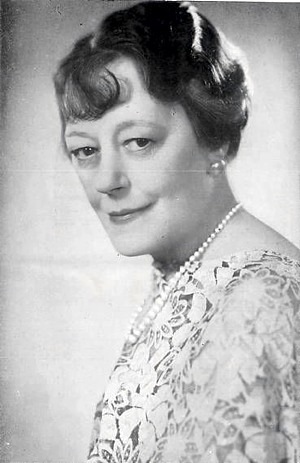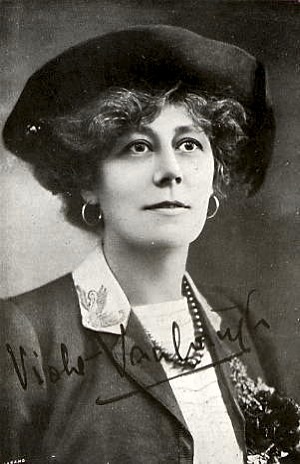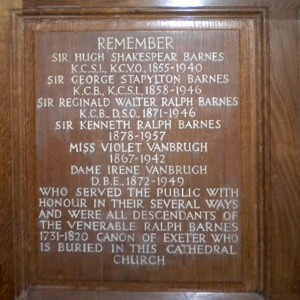
Irene and Violet Vanbrugh - a family history
Researched and written by Julia Sharp
Page added 11th February 2014
Return to Exeter People Menu
It all starts with Charles Collyns
The latter part of the 1700s was a time when Exeter businessmen, sensing the demise of the woollen trade, were looking for other ways of making their mark. In 1770 John Baring, a member of the family who went on to found Baring Bros. Bank was the first to turn to banking by opening, in partnership, the Devonshire Bank. In 1789 an Exeter Ironmonger Charles Collyns became a partner in the Bank. Charles also progressed through the local hierarchy becoming Sheriff of Exeter in 1800 and Mayor in 1802 and 1807. In 1800 Baring retired from the Bank and Collyns took over the day to day management His tenure was not long as in December 1810 an announcement appeared in the Flying Post that the bank ‘ is this day finally closed and our partnership dissolved’, possibly due to other local Bank failures that year.
This must have come as a blow to Charles Collyns as he was very ambitious for his family, especially his oldest son Charles Henry Collyns. Charles Henry had become the Head of Exeter Free School, which, at that time was still in the medieval buildings of St. Johns Hospital near the High Street. The School became Exeter School when it moved to premises in Victoria Park Road in 1880. In 1814 he married Dorothy Collyns who came from Kenton. They had 8 children before Dorothy died in 1838. Following her death Charles Henry gave up his work in the educational field and turned to his other calling, and became Vicar of Farringdon. In 1840 he married Sarah Slade of Poole, who gave him another 3 children. It must have been a very crowded vicarage, although some of the older children soon left to pursue their careers and start their own families.
Mary Jane Collyns was the second of Charles Henry’s children, born in 1818. In 1847 she became the second wife of William Nation, a wealthy non-practising Barrister from Petherton Park in Somerset, who also had property in Rockbeare. William already had two children by his first wife, and Mary produced another six infants. William and Mary occupied a large house 35/6 Southernhay Place, sometime known as the Double House, for their large family. William became a Deputy Lieutenant and also a Magistrate for the City and County of Exeter.
William was keenly interested in the Theatre and was friends with Edmond Kean and other actors including Ellen Terry. When he had time he would tell his family stories about the theatre. One child in particular, Frances, would listen for hours. Although she was not on the stage she was a natural actress and delighted in everything connected with it. However he was not able to continue his tales for long as he died in 1861 from ‘complications caused by gout’.
An interest in theatre – William Hamilton Codrington Nation
William’s oldest son inherited his father’s fortune and used it in part to begin a theatrical career financing productions, none of which proved successful. Indeed he still holds the record for the smallest audience at a performance – 2. Undeterred he continued producing plays, sometimes at Astley’s Theatre in Lambeth which also had a circus ring and was featured in Charles Dickens The Old Curiosity Shop. Proud of being a Devonian he would display pictures of Devon outside his London theatre in place of portraits of actors, or scenes from the play.
Later he published a couple of volumes of poems and songs. One was called Prickly Pear Blossoms and in the early 1900s he gifted through the National Trust 21 acres of land near Rockbeare Hill to be used for recreation and to be called Prickly Pear Blossom Park. He died in 1914.
Reginald Henry Barnes
The Rev. Barnes was born in Exeter in 1831. As a young man he went to Spain and Portugal with friends one of whom was John Lomax Gibbs. After being ordained, Reginald became Vicar of St. Mary Church Torquay. In 1866, he married Frances Nation who was just 18. Their first child Violet was born on the 11 June 1867 at the Double House 35/6 Southernhay Place, home of France's Mother. She was followed by Edith, Angela and Reginald. During this time Rev. Barnes became Vicar of Heavitree in 1869 and started to make his mark on the neighbourhood. Two further children arrived, Irene in 1872 and Kenneth in 1878.
At the end of 1883 General Gordon came to visit his old friend, just before he left for Sudan on 14 January 1884. One day Reginald and General Gordon walked to Exwick to have a chat with John Gibbs, who, by then was Vicar of Exwick, just a stroll for them, but a hike for us today. Rev. Barnes went on to become a Prebendary of Exeter Cathedral in 1888, but the family moved to London in 1889, a few months before he died. Frances married for a second time in 1895, becoming Mrs. George David Young.
Frances must have instilled her love of the theatre in her children, as most of the girls, at least, grew up to have some connection with the stage. Edith and Angela became violinists, but Edith soon married and moved to India with her husband. Angela became a professional violinist using the same name as her sisters, Vanbrugh, but could have chosen to be a dancer. She also married a soldier serving in India, quite near to where Edith was living. Another Barnes sibling also chose to become a professional Soldier, Reginald. He was awarded the DSO in the Boer War and subsequently a knighthood.
Violet Vanbrugh
Violet had, from a young age, wanted to go on the stage. This was not considered proper for the daughter of a distinguished Clergyman. By 1884 she had expressed her wish, much to the consternation of her Father and other relations in the know, to become an actress. Her Father was very mindful of the dangers she might encounter, but her Mother was heart and soul in favour of grasping the opportunity. Finally, he gave his consent and she left for Margate where she underwent a spell of training with Sarah Thorne at the Theatre Royal in Margate, making her first stage appearance there in 1886.
The decision to use the name Vanbrugh as a stage name is said to result from a suggestion by Ellen Terry, who was perusing a book ‘Miss Vanbrugh, the Actress’ and suggested it might be a good name for Violet to use.
Violet’s career took off with Ellen Terry helping her obtain her first professional role in London later in 1886, the first of many roles including Shakespeare and comedies. Her first tour of the US was in 1889, with the Kendalls. On her return more roles came thick and fast. In 1893 she appeared with Arthur Bourchier at Daly’s Theatre, and they married the following year.
Arthur Bourchier launched himself as an actor-manager using a number of Theatres in London, with Violet the leading lady for many productions. By this time Irene, her sister, had followed in her footsteps and joined Violet touring America in 1897. In 1902 Violet had a daughter Prudence, who became an actress, with the stage name Vanbrugh.
Around this time Exeter and other Provincial towns were the destination for ‘Flying Matinees’. Actors like Violet and Arthur would come to Exeter in time for a show commencing at 2pm, returning to London immediately afterwards. One of Violet’s first such performances was in 1911, and she came repeatedly in 1916, 1918 and onwards. Violet’s career progressed but the marriage floundered, the pair being separated in 1916 and divorced in 1918. Violet, like many actresses, took to the screen in silent films, the first being Henry VIII in 1911.
Prudence followed her mother on to the stage and in 1924 they both came to the Hippodrome Exeter where ‘Miss Violet Vanbrugh’s London Company performed “Evening Dress Indispensible” the playlet being supported by a good variety bill’. Prudence played Sheila Waybury with Violet as her Mother Mrs. Waybury (type casting or what!)
Violet continued to come to Devon on occasions including in 1931, a visit to Pavilion Torquay for a ‘personal visit of Violet Vanbrugh in Van Druten’s Latest Success “After All”. Her career did not end until 1940 and included the film Pygmalion in 1938 and the Merry Wives of Windsor with her sister in 1939. Her final appearances were morale boasting lunchtime appearances at the Strand Theatre during the Battle of Britain with Donald Wolfit and her sister Irene.
She died in 1942 at the age of 75.
Dame Irene Vanbrugh
Dame Irene Vanbrugh was five years younger than Violet but also stricken with the acting bug. She followed Violet in learning her craft at Sarah Thorne’s School of Acting in Margate. While a student there in 1888, she made her first appearance on stage as Phoebe in As You Like It, Violet taking the part of Rosalind. Lewis Carroll, a friend of her father, saw her there and recommended her to a London producer. This resulted in Irene making her London debut in Alice in Wonderland, with her sister Edith, on Boxing Day 1888.
Like her sister Violet she joined J.L.Toole’s Company and played in many comedy successes. The company went to Australia in 1890, where Irene played in every play in the repertoire, which she considered better training than the Margate experience. The plays were so varied as were the type of audience who would find ‘one’s weak points’. During the rest of the 1890’s she continued working almost continuously, before, in 1899 she played the role of Sophy Fullgarney in Pinero’s The Gay Lord Quex, the role that made her name. The play was regarded as risqué, and one critic commented that had Lewis Carroll still been alive, he would have approved of “Miss Vanbrugh’s greatest triumph” but probably not of the play. Although Irene does not appear to have played this part herself in Exeter, later that year Messrs. Morell and Mouillot’s Company came to the Theatre Royal with The Gay Lord Quex with ‘Miss Minna Blakiston playing the part in which our own Irene Vanbrugh has “set all London on fire”’, according to the Exeter Flying Post.
In 1901 she married Dion Boucicault jnr. and the Western Times tells us her favourite life, apart from the stage, is a simple country out-of- door life, and the courtship took place while they were cycling together. Unlike her sister the marriage was a success with Dion becoming her manager in 1915, and they frequently appeared together until his death in 1929. The couple did not have any children.
Between the turn of the century and World War 1 she had leading roles in many plays including J.M.Barrie’s new play The Admirable Crichton. In 1913 she also appeared in a charity performance of her father-in-law’s play London Assurance, in aid of King George’s Pension Fund for Actors and Actresses. During the War she continued to grace the boards, and also ventured into the realm of silent movies including a silent film version of The Gay Lord Quex.
After the end of World War 1 she continued to act on the stage, including in 1918 taking the title role in A.A.Milne’s Belinda. In 1919 she had the old film Masks and Faces remade with a star cast, the proceeds going to help save the Academy of Dramatic Art theatre, where her younger brother Kenneth was Director. From 1927 to 1929 she toured Australia and New Zealand. The 1930s were no less hectic.
In 1938, she celebrated her Golden Jubilee as an Actress, when she was given a testimonial matinee at His Majesty’s Theatre on 20 June 1938, which the then Queen attended. This raised £2245 which was divided between Elizabeth Garret Anderson Hospital and the Theatrical Ladies’ Guild.
She continued her appearances on stage and in 1939, she created the role of Catherine of Braganza in George Bernard Shaw’s In Good King Charles’s Golden Days when it was produced at the Malvern festival. Its transfer to the West End was stopped by the start of the Second World War.
During the Battle of Britain she took part with Violet and Donald Wolfit in the lunchtime performances at the Strand Theatre. In 1941 she was made a Dame Commander of the British Empire. She continued to work in the West End and touring the country with a number of new plays and as well as classics.
She not only trod the boards but had appeared in 10 movies, her last appearance being in 1945 in A Yank in London also known as I live in Grosvenor Square when she had a cameo role as an actress portraying Dame Irene Vanbrugh. In the same year she made her last appearance in Exeter in Appointment with Fear.
She worked until the end of her life. In November 1949 she appeared in a pre-London run of Mary Bonaventure, but was taken ill and died within days, a few days short of the 77th birthday.
Sir Kenneth Barnes KGB CBE
Kenneth Barnes was born in 1878, the youngest child in the Barnes family. After University he became a civil servant in the Land Registry. Then, in 1909, he was given the opportunity to be the Director of the then Academy of Dramatic Art which had been set up five years earlier by Herbert Beerbohm Tree. He continued to hold that post, apart from active service in World War 1, until 1955.
His sisters actively supported him in his work, and he remained close to them, and they him. In 1920 the Academy was given the title of Royal Academy of Dramatic Art, at the same time as a new theatre opened. This was destroyed in the Blitz of 1941. A replacement theatre was built after the Second World War and opened in 1954, a few months before Kenneth retired. It was called the Vanbrugh Theatre in honour of his sisters, and it was opened by Queen Elizabeth the Queen Mother. In the same year RADA celebrated its Golden Jubilee.
He married Daphne Graham, a former student of RADA in 1925, and died in 1957 at the age of 79.
Memorial in Exeter Cathedral
On a stall near the High Altar of the Cathedral is a plaque asking us to remember six descendants of the Venerable Ralph Barnes sometime Vicar of Heavitree, and Canon of Exeter who is buried in the Cathedral and whose memorial is in the south quire aisle. Four of these are children of Rev. Reginald Barnes, namely Sir Reginald Barnes, Sir Kenneth Barnes, Miss Violet Vanbrugh and Dame Irene Vanbrugh and we are asked to remember them for serving the public with honour in their several ways.
Sources: Cavalcade by Candlelight, various items on the internet and sundry newspaper cuttings
 Dame Irene Vanbrugh.
Dame Irene Vanbrugh.  Violet Vanbrugh.
Violet Vanbrugh.  The Memorial in Exeter Cathedral to the Venerable Barne's children. Photo Julia Sharp.
The Memorial in Exeter Cathedral to the Venerable Barne's children. Photo Julia Sharp.
│ Top of Page │